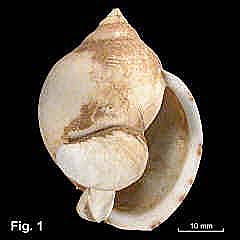|
|
|
|
|
Malluvium devotum (Hedley, 1904) Description: Shell limpet-shaped, with apex spirally coiled, projecting past rear edge of shell and offset to the right of the body whorl axis. Sculptured with irregular concentric growth lines; axial sculpture absent. Margin irregular, conforming to substrate surface. Colour white internally and externally, occasionally with several broad, axial tan rays. Thin brown periostracum present towards the margin of live shells. Size: Up to 19.5 mm in length. Distribution: Endemic to Australia; known from Cape Moreton, Queensland, southwards to Cape Wiles, SA, including Tasmania, but probably extends further westward along the southern Australian coast. Habitat: Known from 80-600 m. Very common. Remarks: This species is usually found attached to dead gastropod shells inhabited by hermit crabs. Many specimens may be found on a single shell, varying in size from a few millimetres up to adult size. Large shells form a calcareous saucer upon which the Malluvium sits, remaining there sedentary for all their adult life. The largest Malluvium on each host shell is usually centrally placed on the inner lip of the aperture, with the inner edge of the saucer built up to form an approximately level surface. This species is a protandrous consecutive hermaphrodite (i.e. male first, then female). Egg capsules, each with about 20 embryos, are brooded in the mantle cavity of the female. The anatomy of the species is described by Simone (2002). Fig. 1: Off Sydney, 420-440 m (DLB4163) Fig. 2: Same specimen as Fig. 1 |

